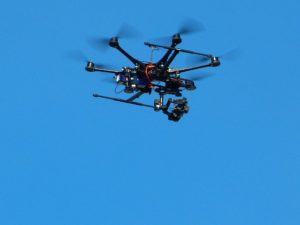The FAA has published new drone rules for Remote ID and Operations Over People. While it will take some time to fully unpack the final rule on Remote ID, the drone industry is weighing in on the new regulations and the impact that they will have. (See the announcement with links to the full text of the rules, and a Q & A on Remote ID from DRONERESPONDERS.)
AUVSI has been a vocal proponent of moving forward with the new drone rules, joining other industry stakeholders in writing a letter earlier this year asking the FAA to keep their promise to release the rules by the end of the year. Calling the new rules “critical steps” towards Unmanned Traffic Management (UTM), flight Beyond Visual Line of Sight (BVLOS), public safety operations and infrastructure inspection, AUVSI said the publication represented progress.
“AUVSI welcomes the progress made with the delivery of these final rules,” said AUVSI President and CEO Brian Wynne. “Remote ID will enable more complex UAS operations, which will have additional untold benefits for American society. Operations over people, and at night, are important steps towards enabling integration of drones into our national airspace. We look forward to reviewing these rules and working with the FAA on implementation.”
Others agree that publication of the rules is a demonstration of progress towards drone integration. “While the implementation of remote identification technology may appear somewhat daunting for UAS program managers and operators who have already invested substantial budget towards building out their drone fleets, the finalization of the Remote ID and Operations Over People rules truly represent a significant milestone that ought to be celebrated by UAS professionals seeking to establish the safest possible ecosystem for unmanned aviation operations in the National Airspace System,” said Christopher Todd, Executive Director, Airborne International Response Team (AIRT), the leading 501(c)3 non-profit organization supporting Drones For Good.
Recreational Flyers and the AMA
The Academy of Model Aeronautics (AMA) was among those organizations who had expressed concern over the initial Remote ID NPRM, fearing that the rule would not easily accomodate recreational drone flight. Now, Tyler Dobbs, AMA Director of Government Affairs, says that the published rule addresses many of those concerns.
“The final remote ID rule prioritizes the safety and security of the national airspace, while also accommodating the longstanding, safe hobby of flying model aircraft. The rule sets forth requirements that will allow seasoned aviators and burgeoning pilots to continue enjoying our hobby responsibly. Flying model aircraft has proven to be an effective tool for generating interest in high-demand STEM-related fields, such as aviation, engineering and aerospace,” says Dobbs in an AMA statement.
“The final rule allows UAS without remote identification to be operated within FAA-Recognized Identification Areas. This option for meeting remote identification requirements has been included in the final rule as a long-term solution. AMA maintains nearly 2,400 fixed flying sites across the country where our members have flown safely and responsibly for decades. All unmanned aircraft at these locations are flown within visual line of sight of the operator, making it easy to ensure safety and identify the operator.
“The final rule also includes a sensible solution for operating outside of FAA-Recognized Identification Areas with the use of remote identification broadcast modules. This option eliminates the internet connectivity requirement that was included in the proposed rule and allows for retrofitting existing model aircraft.”
“We are pleased the FAA reversed the proposal to require model aircraft owners to register each of their model aircraft separately. Now, unmanned aircraft operators flying under the Exception for Limited Recreational Operations can continue to simply register per individual with the FAA.”
Flight Over People
Dawn Zoldi, CEO of P3 Consulting, has written a deep dive at Inside Unmanned Systems. Zoldi points out that Ops over Moving Vehicles is a major move forward for advanced operations. “The big news is this rule allows operations over moving vehicles and the humans inside—but think beyond cars and trucks as the meaning of the term per the FAA also includes vehicles such as rollercoasters, bicycles and jet skiis,” writes Zoldi. “This is a very, VERY welcome change from the NPRM.”
Flight at Night
On Twitter, DJI’s VP of Policy and Legal Affairs Brendan Schulman says that in addition to Ops Over People, the rule on Night Operations is an important step forward for many rescue and humanitarian applications. “There will be lots of attention this week on the new Remote ID and Over-People rules, but the seemingly less-noticed Night Operations rule is how drones will save lives,” Schulman tweets. “Many of the 524 rescues on our interactive map are from operations at night.”
What’s Next?
“Big FAA releases are becoming an annual holiday tradition. Just like the jelly of the month club, RID and OOP should be the gifts that keep on giving all year long!” Zoldi quips. “Seriously, these two long-awaited rules should help move the drone industry closer to repeatable and scalable ops. I’m definitely adding a draft BVLOS rule to my wish list for next year!”
Miriam McNabb is the Editor-in-Chief of DRONELIFE and CEO of JobForDrones, a professional drone services marketplace, and a fascinated observer of the emerging drone industry and the regulatory environment for drones. Miriam has penned over 3,000 articles focused on the commercial drone space and is an international speaker and recognized figure in the industry. Miriam has a degree from the University of Chicago and over 20 years of experience in high tech sales and marketing for new technologies.
For drone industry consulting or writing, Email Miriam.
TWITTER:@spaldingbarker
Subscribe to DroneLife here.
https://dronelife.com/2020/12/28/industry-weighs-in-on-new-drone-rules-for-remote-id-flight-over-people/
 Unmanned Aerial Vehicle The latest drone news
Unmanned Aerial Vehicle The latest drone news




